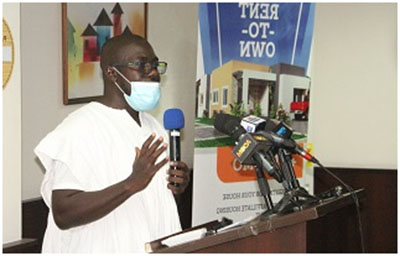Daniel Ohene Aidoo addressing the media
CITIES AND Habitats Gh. Limited, under the Planned City Extension Project’s Land and House Ownership Scheme – Rent-to-Own – has announced a special lifeline package for civil servants.
Daniel Ohene Aidoo, Project Manager of the Planned City Extension Project, who made this known to the media Tuesday in Accra, said the Rent-to-Own was an income responsive housing targeted at easing the pressure on civil servants and government workers to acquiring a home.
Mr Aidoo said the project, which was currently taking place in the Ningo-Prampram district, included a two-bedroom semi-detached house which was going for ¢550.00 monthly for a 25-year-period at a total cost of ¢364,967.76 and a three-bedroom at ¢770.00 monthly for a 25-year-period at the total cost of ¢509,754.12.
Nevertheless, the payment swells by 10 percent each year until the eleventh year when it remains constant until all payments are made.
“Thousands of residential housing units, commercial, industrial, recreational, educational, health, religious plots and central business districts are coming up under this project, beginning from Ningo-Prampram sites.
“We have put together a special lifeline package for civil servants to meet their income bracket. This, we believe, is unrivaled and has the potential to alleviate the frustrations of many government workers in the area of housing,” he noted.
Mr. Aidoo added that in situations where there was temporary loss of income or a client becomes invalid or dies, a member of the housing cooperative, “in good standing”, would be supported to recover, depending on the number of years that they have paid for the house.
Mr. Aidoo gave assurance that there would be other packages for private workers and journalists soon as the project expanded to other parts of the country.
The Planned City Expansion Project’s Land and House Ownership Scheme (LAHOSE), a rent to own scheme, is a hybrid of workable housing delivery systems or approaches and pivoted on making good planning and engineering work for us, inclusion of the low-income groups and maximising spatial development for current and future needs.”


